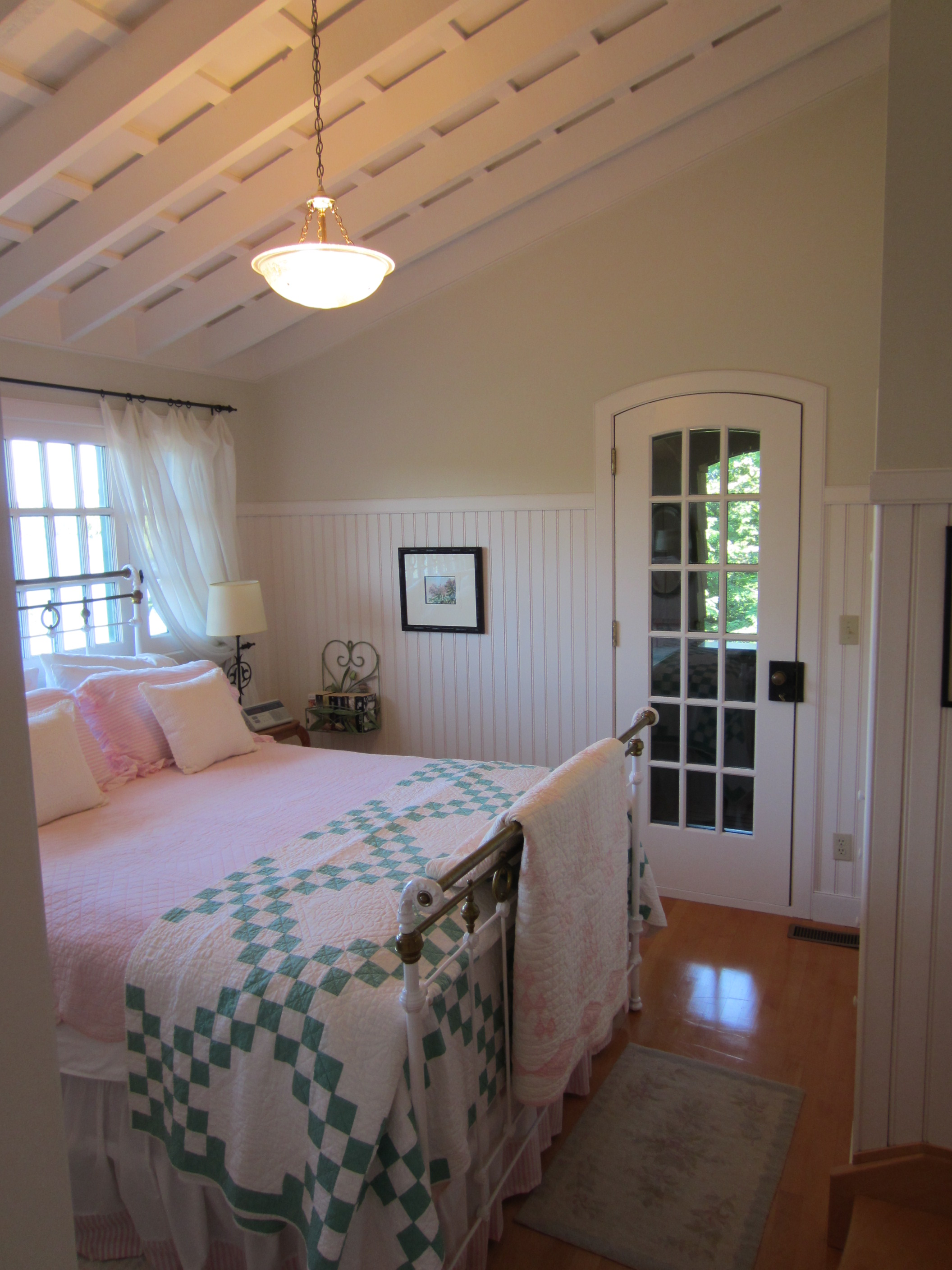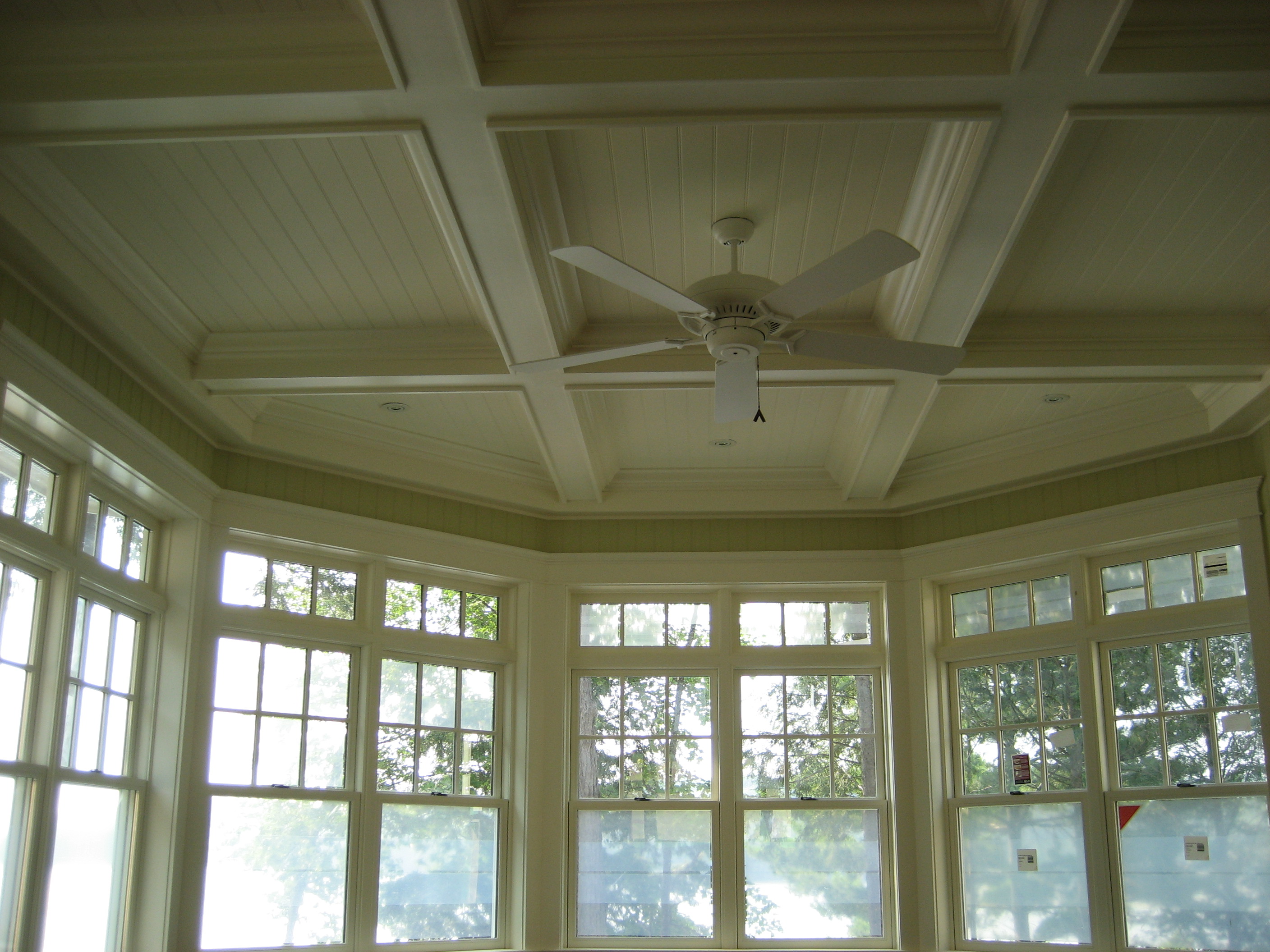Dressing the ceilings of the main rooms is especially desirable in a cottage to bring that “cottage look” that differs from city homes. Traditionally cottage ceiling were made of wood, and not drywall, bringing the flavour of natural materials to the rooms
Ceilings are sometimes called the fifth and most important wall. It is surprising how powerful a visual effect is created by adding dimension or texture to the ceiling. If you have to decide between dressing the walls, or dressing the ceiling, it is best to favour the ceiling.
The height of your ceiling, or the way a ceiling changes height can define a room within an open area, can create drama, or frame a view. It is not hard or expensive to curve a ceiling, especially in a hallway or a small room, creating visual delight and a nautical feeling. This can even be done after construction is finished as it is quite a simple process.
Tongue and grooved wood, bead board, board and battens, beaverboard and battens, and shiplap were traditionally used on Muskoka cottage ceilings and they create texture and a beautiful effect. Either wood or MDF can be effectively used for each of these types of ceilings


Because all wood shrinks and expands with the seasons, it is good to prepaint the lumber before it goes up. This is because if you paint tongue and groove after it is installed on the ceiling, the tongues of the tongue and groove do not get covered and will show as wood, rather than painted or stained, when the wood shrinks over the winter. The tongues often disappear again in the summer when the wood swells. It is important to know the moisture content of the wood that is being used to build your interior ceiling or walls, because if the wood is too dry it could buckle when it takes on moisture in the summer. A moisture content of between 10-12% is best.
If you choose to paint your wood ceilings, be sure that the knots in the wood are well sealed and the wood is well primed before the paint is applied. Knots are persistent in their ability to bleed through paint. Do not underestimate the ability of knots to show through your beautiful paint job after several months even when well primed. They require special attention.
MDF can substitute for wood tongue and groove, bead board, battens or shiplap on the ceiling. MDF being a very stable material, will not shrink or expand with the seasons, and it takes paint beautifully. Be aware, however, that the savings you make in purchasing MDF may be used up in the increased labour cost of building with it. Discuss this issue with your contractor. It is also important to know that when MDF comes in a nine inch board with three boards routered into that single board, the joins between the boards will show, unless they are hand filled. Be aware also that several boards will appear to butt together unlike wood tongue and groove in which single boards butt to one another. When making the decision between wood or MDF, all the facts must be given careful consideration to achieve a final result that looks great, wears well over the years, and will give you good resale value.
Other less expensive ways to dress the ceiling are with rough pine, beams, or battens.
Rough pine is traditional on ceilings of un-insulated cottages, as what you actually see is the underside of the roofing material. If you are going to mimic this look, be sure to put black paper under the installation of the wood ceiling so that it covers the insulation and provides a black background for any cracks or gaps you can see through. Use of rough pine creates a rustic “cottagey” look at a reasonable price, as it is inexpensive to buy and is very quick to apply, compared to the labour intensity of tongue and groove. It looks especially good painted creamy white.
Faux beams can be installed on either a drywall ceiling or a wood ceiling. They can be left natural or can be painted or stained. If they are left natural they have the effect of lowering the ceiling and they create a visual weight above you. If they are painted they do not lower the ceiling as much, while still adding visual interest and shadowing. When they are for decorative, not structural, purposes, beams are usually made up as three sided boxes with mitered edges so that they are light and easy to install. It is possible to hang authentic recycled barn beams, but they are very heavy and will take engineered accommodation, unlike made up faux beams.
A drywall ceiling can be made to have more dimension and interest with the use of wood battens on it. These can be laid in a regular linear pattern across the ceiling, or they can be organized to create large blocks covering the ceiling. It will be necessary to use some wood fill as neither the ceiling nor the batons will be totally flat and fit tightly against one another. This is a very inexpensive option as the batons are inexpensive to purchase and it requires little labour to install them. They are secured with a combination of adhesive along the whole board and nails into the ceiling joists.
Faux panels can be made for the ceiling by cutting out drywall sections, and installing them over top of the dry-walled ceiling. These sections are then trimmed with narrow moulding to finish the look. This is a formal look that suits the city more than Muskoka.
If you choose to have plain drywall ceilings, consider using a warm white colour of paint rather than ceiling white. This will create a warmer, less formal atmosphere in the room, commensurate with a cottage. You may want to put some rough flat crown moulding where the walls meet the ceiling to add texture

